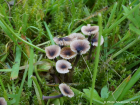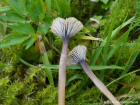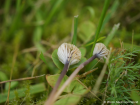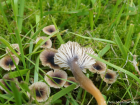Cap initially convex and then expands to become nearly flat, occasionally having a central depression that gives it an infundibuliform (funnel-like) shape. The cap's margin is usually curved downward and is occasionally wavy. The colour of the cap is dark brown at the centre (disc) and transitions to a pale tan shade towards the margin. The flesh is cream-coloured and very thin. Gills pallid, deeply decurrent, fairly well-spaced, at first whitish, then cream-coloured. Stem rounded and mostly equal in width, with a slight enlargement at the apex. Its surface is similar to the cap, with a powdery texture (pruinose), particularly at the apex. As the mushroom ages, the stem becomes almost smooth (nearly glabrous). The colour of the stem ranges from dark vinaceous-brown to bluish-black at the apex, transitioning to a pale buff-orange shade below. There is no partial veil present. Spore print whitish.
Microscopic Features: The spores are elliptical in face-view, slightly inequilateral in profile, and measure approximately 4.0-5.5 (6) x 2.5-3.5 µm. They have a smooth surface, thin walls, granular contents, and a well-developed hilar appendage. The spores are inamyloid.
Rickenella swartzii on the mykoweb.com Web site.
Many mushrooms are poisonous, and some can be lethally toxic. Distinguishing between edible and poisonous mushrooms can be very challenging. Therefore, we strongly advise against consuming wild mushrooms. This website does not contain any information about the edibility or toxicity of mushrooms.
Although efforts have been made to ensure accuracy on this website, the information may contain errors and omissions. Therefore, all content provided is for educational and informational purposes only and should not be relied upon or used as a basis for consuming any plants or mushrooms.
External links are provided for reference only. We do not endorse or take responsibility for the content, advice, or products found on these sites or in any advertisements shown on this website.



